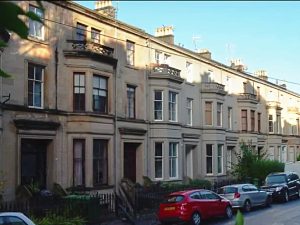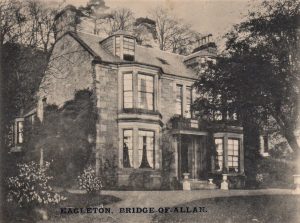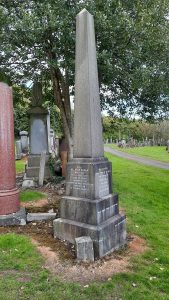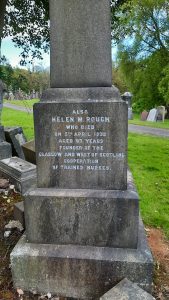Helen Marshall Rough 1839-1932
By Keith Clark and Morag T Fyfe
According to records May 1819 was an unusually cold month when 17-year old Margaret Gardner, daughter of a hairdresser, married 27-year old Archibald Rough who ran a successful upholstery business in Edinburgh. Soon the family was growing; Margaret (1821), Jane (1826), Isabella (1827), Archibald Jr. (1829) and George (1831). By 1832 the family had moved to Leith Walk the long street connecting Edinburgh to the port of Leith where the last of their eight children were born; Lewis (1834), Elizabeth (1836) and Helen (1839). It was the couple’s youngest child, Helen Marshall Rough, who was to have an influence on the nursing profession in Scotland, an influence that extended for several generations beyond her death in 1932.
We know little of Helen’s childhood. At the time of the 1841 census 2-year old Helen was living on Leith Walk with her parents and maternal grandmother. As a 4-year old, Helen probably attended the wedding of her sister Margaret in 1843, and, at age 7 she most likely was at the 1846 wedding of her sister Jane to Mr. James Bell, a highly respected educator in Edinburgh who had moved to Glasgow in 1844. Her sister’s marriage to James would later have a significant influence on Helen’s life. Eight year old Helen felt the anguish of her mother’s death in 1847 from “fever”, either cholera or typhoid, which were sweeping over the country at this time.
The 1850’s brought more changes to the growing Helen. In 1851 she was living with her father, four of her siblings and a servant at 18 Leith Walk while attending school. Her sister, Elizabeth, had moved out of the house to live with her married sister, Jane Bell, in Glasgow for a period of time. An elder sister, Isabella, emigrated to Canada West and married there. Her brother Archibald, who had been living at home, was declared bankrupt in 1858 and the next year her father followed suit. By the time Helen was twenty her mother had died, her brothers and sisters were moving out, getting married and having children, and her father and brother had declared bankruptcy. Certainly her teenage years would have been challenging for her.
No much is known about Helen’s story during the 1860s. The 1861 census shows Helen living at home on Leith Walk with her father, who had apparently recovered from his bankruptcy as he was still a master upholsterer and employed three men. Living with them were Helen’s sister Elizabeth, her brother Archibald as well as her six year old nephew James Johnson, her sister Margaret’s son.
It was during this decade that Helen’s family dispersed and left her childhood home on Leith Walk. In 1861 her brother Archibald married but died in 1863. Her sister Elizabeth left home and married in 1864 and her father quit the house in Leith and moved in with his daughter Margaret.
By 1871, 32 year old Helen was living with her brother-in-law, James Bell, at 8 Kew Terrace in Glasgow. Her sister Jane had died suddenly the year before; had Helen come to Glasgow to keep house for her brother-in-law after her sister’s unexpected death?
The Bell household on Kew Terrace that Helen moved into was an energetic one. James Bell was a devout Christian who was active in the church and reached out to the poor, sick and underprivileged of the city. As English Master at the High School of Glasgow, Bell was respected in the community and an inspiring and highly effective teacher. As his students assumed their adult roles in the community some of them became friends with their former teacher.
In 1878 James became unwell and Helen tended to him in his final days. On the night of Friday 25 July 1879 he was ill and she sat up the night with him. The next day he died of a stroke. It was Helen who received letters of condolence from several of the organizations that her brother-in-law had served, so she was obviously associated with him in their eyes. Was it from James’ network of friends and associates that Helen was able to draw support from when she embarked on founding her organization over a decade later?
After the death of her brother-in-law James Bell, Helen took some time for herself. Her father had died in Edinburgh in 1875 so she had no family home to return to. The census of 1881 shows her visiting at 15 Westfield Park, Westbury upon Trym, Barton Regis, Gloucestershire, England with the family of Rev Richard Glover, an influential Baptist Minister. Helen is listed as a visitor “Deriving Income from Her Property”. Rev. Glover was a friend and admirer of James Bell and Helen probably became acquainted with him while she was living in Glasgow with her brother-in-law. It is also unknown how she supported herself during this time. When James Bell died in 1879, he left an estate of just over £3,500, the bulk of which was split between Helen and her sister Elizabeth so Helen now had some money of her own.
Sometime in the 1880’s Helen may have enrolled in the Glasgow Training Home for Nurses on St. George’s Road to train as a nurse, most likely under the supervision of a Miss Annie Stewart. In 1889 Miss Stewart left the Glasgow Training Home for Nurses and established the Blysthswood Nursing Institution at 20 & 22 Burnbank Terrace. The purpose of the institution was for the reception of patients, and supplying of medical and surgical nurses to private families. The 1891 shows 52-year old Helen employed there as Sick Nurse.
In her work, Helen must have realized the critical role that nurses were now playing in both the medical community and in serving the needs of those who needed private nursing. To help link these three groups Helen set out to create the Glasgow and West of Scotland Co-operation for Trained Nurses (The Co-operation) towards the end of 1892. The organization was based on a model of a nurses Co-operation that had been developed in London by a Miss. Hicks the year before. Helen solicited money and sought the help of friends and by April 1893 she had created a working committee to establish a nurses Co-operation for Glasgow and area.
The stated aim of the Co-operation was to improve nurse’s working conditions. This was to be done by establishing a register for trained nurses in Glasgow, providing them with regular employment and full remuneration, and providing a central home where nurses could live comfortably for a moderate fee. Each member nurse paid the Co-operation a commission and the Co-operation matched them to appropriate nursing cases at the request of the medical community. The nurses had to be supervised and Helen became the first Lady Superintendent of the Co-operation. A house was leased in late 1893 at 18 Sardinia Terrace in Glasgow for use as the organization’s headquarters and nurses’ residence, and by year’s end Helen had enrolled 31 nurses.
On Friday afternoon 12 January 1894 the first annual meeting of members of the Board of Directors was held at Sardinia Terrace. Dr Joseph Coats took the chair and Mrs Isabella Elder agreed to become first president of the organization. Throughout its history the Board of Directors had many well connected people on it, probably through Helen’s association with her brother-in-law James Bell and his ties to the church and Glasgow in general.
The first few years were a struggle for the young organization and it was noted in the minutes of one of the meetings that Helen did not draw a salary during this time. However by 1897 the Co-operation was starting show a profit and become self-sustaining. The Co-operation continued to grow under Helen’s leadership and between 1899 and 1903 the nurses of the Co-operative handled nearly 7000 cases.
The war years presented a challenge for Helen and the Co-operation. She remained Lady Superintendant, living and working at an expanded Sardinia Terrace building. During this time, nurses left the Co-operation to join the war effort resulting in a loss of £2,093 in revenue in one year alone. However with Helen’s leadership the organization was still able to continue functioning at a small profit. Helen continued to work for the nurses of the Cooperation and it was proposed to add a pension fund to its existing benevolent fund for member nurses.
Insight into the feelings of the nurses towards Helen can be seen in this excerpt from The British Journal of Nursing (March 11, 1916)
“They (the nurses) write to Miss Rough ……. at the home in a bright and cheerful manner.
With the end of the war Helen decided to retire and in 1919, at age 80, she left the organization that she founded, nurtured and grew into one that had served over 40,000 clients during her tenure. She had established a safe home for nurses in Glasgow and provided them with a benevolent fund and a pension fund. The medical community of Glasgow knew that the organization Helen founded would provide them with well trained and reliable nurses.
Upon retirement, Helen left Glasgow and moved to Abbey View in Bridge of Allan to the north of Stirling. She later took up residence at the Eagleton Hotel on Henderson Street there where she resided until her death on 5 April 1932 leaving an estate of just over £3,300. Helen is buried in the Glasgow Necropolis beside her sister and brother in law Jane and James Bell in Compartment Upsilon.
The Glasgow & West of Scotland Co-operation for Trained Nurses continued to operate until 27 October 1964. At that time its business was wound up and its funds were transferred to The Trades House of Glasgow that continued to administer the pensions and the benevolent funds – the tangible legacy of Helen’s organization. For more information on the Co-operation see here.
References for Helen M. Rough
Alloa Advertiser 23 April 1864
British Journal of Nursing Issues: 16 July 1910 p. 49; 25 Jan 1913 p. 71; 13 Feb 1915 p. 134; 111 March 1916 p. 234; 13 April 1918;
British Weather from 1700 to 1849 (pascalbonenfant.com)
Burdett’s Hospitals and Charities 1899 p. 672
Census of Scotland Years: 1841, 1851, 1861, 1871, 1881, 1891, 1901, 1911
City of Glasgow City Directory Years: 1902, 1904, 1917-18, 1918-19, 1920
Dundee Advertiser – 15 January 1894
Dundee Courier 6 Nov 1862
Dundee Evening Telegraph 12 April 1932
Edinburgh City Archives; Edinburgh, Scotland; Register of Voters For the City of Edinburgh and the Burgh of Leith Years: 1832, 1856-57, 1857-58, 1858-59
Edinburgh City Directory Years: 1829-30, 1841-42,
Edinburgh City Voters List 1852
Edinburgh Evening News 18 Dec 1903
Glasgow Herald – 20 Jan 1896 page 9
Glasgow Herald – November 1894
Glasgow Herald 22 December 1893
Glasgow Medical Journal. v.89 1918 p. 74
Glasgow Saturday Post, and Paisley and Renfrewshire Reformer 28 Dec 1861
Greenock Advertiser 28 April 1864
https://www.biblicalstudies.org.uk/pdf/bq/35-3_108.pdf
https://www.scottishindexes.com/mcsearch.aspx; Archive: Scottish Indexes; Archive Location: Glasgow, Scotland
In Memoriam James Bell, David Bryce & Son, 129 Buchanan St, Glasgow, 1879
North Briton – 21 July 1858
Old Parish Registers Deaths and Burials 685/2 590/14 St Cuthberts – National Records of Scotland
Old Parish Registers Marriages 685/3 190 249 Canongate Page 301 – National Records of Scotland
Sun (London) – 10 July 1858; 15 Feb 1859
The Canadian Nurse Volume 4 1908 p. 77
The Lancet Issues: 20 Jan 1894 p. 186; 28 March 1903 p. 921;
The Nursing Record, No 176 Thursday, August 13, 1891
The Scotsman Issues: 20 Nov 1912; 26 Nov 1920; 29 Nov 1922; 7 April 1932
Will of Helen Marshall Rough
Will of James Bell













